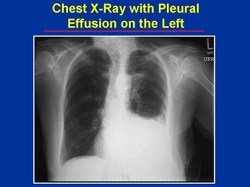Medicine Notes- Clinical Examination - Pleural Effusion

Pleural effusion
There are two form of pleural effusion which are transudate pleural effusion and exudate pleural effusion. Transudate pleural effusion occurs due to hypoproteinemia and congestive heart failure.Transudate effusion usually involve bilateral effusion. Exudates pleural effusion occur due to rheumatoid arthritis, systemic lupus erythematosus, tuberculosis, bronchogenic carcinoma, mesothelioma and other form of malignancy. Exudate effusion is associated with unilateral effusion.
Patient complain of shortness of breath and appear cachetic in nature. Patient with pleural effusion may develop signs of clubbing. The jugular venous pressure is raised.Trachea will be deviated away from the sides of effusion. There will be decrease of chest expansion on the affected sides. There will be stony dull on percussion on the sides of pleural effusion. There will be decreased vocal fremitus and decreased or no breath sound on the affected pleural effusion area.
The treatment of pleural effusion will focus on drainage in symptomatic patient after performing pleural tap. Pleural tap is useful for diagnosis. Pleural tap involves microscopy, cytology, culture,pH and biochemistry analysis as well as protein and glucose. pH less than 7.2 is an indication of pus.
There are two form of pleural effusion which are transudate pleural effusion and exudate pleural effusion. Transudate pleural effusion occurs due to hypoproteinemia and congestive heart failure.Transudate effusion usually involve bilateral effusion. Exudates pleural effusion occur due to rheumatoid arthritis, systemic lupus erythematosus, tuberculosis, bronchogenic carcinoma, mesothelioma and other form of malignancy. Exudate effusion is associated with unilateral effusion.
Patient complain of shortness of breath and appear cachetic in nature. Patient with pleural effusion may develop signs of clubbing. The jugular venous pressure is raised.Trachea will be deviated away from the sides of effusion. There will be decrease of chest expansion on the affected sides. There will be stony dull on percussion on the sides of pleural effusion. There will be decreased vocal fremitus and decreased or no breath sound on the affected pleural effusion area.
The treatment of pleural effusion will focus on drainage in symptomatic patient after performing pleural tap. Pleural tap is useful for diagnosis. Pleural tap involves microscopy, cytology, culture,pH and biochemistry analysis as well as protein and glucose. pH less than 7.2 is an indication of pus.
